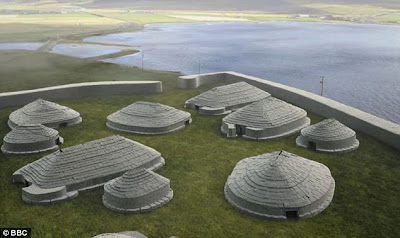The archaeology discovery of a Stone Age temple on Orkney looks set to rewrite the archaeological records of ancient Britain with evidence emerging it was built centuries before Stonehenge.
Archaeologists have so far found undisturbed artefacts including wall decorations, pigments and paint pots, which are already increasing their understanding of the Neolithic people.
Experts believe the huge outer wall suggests the site was not domestic, while the layout of the buildings has reinforced the view it might have been a major religious site. Archaeologists think the temple was built 500 years before Stonehenge, regarded as the centre of Stone Age Britain.
However, only 10% of the site at Ness of Brodgar has been excavated and it could be years before the scale and age of the discovery is fully understood.
It sits close to the existing Ring of Brodgar stone circles and the standing stones of Stenness, near to the town of Stromness.
The uncovered wall around the edges of the site was built with 10,000 tonnes of quarried rock and may have been up to 10 ft high.
Thermal technology also indicates the site could cover the same area as five football pitches, with some parts potentially older than Stonehenge, in south-west England, by as much as 800 years.
Charcoal samples from beneath the wall indicate it was built around 3200 BC. A 30mm high figurine with a head, body and two eyes, and called the "Brodgar Boy", was also unearthed in the rubble of one of the structures.
About 18 months ago, a remarkable rock coloured red, orange and yellow was unearthed. This is the first discovery in Britain of evidence that Neolithic peoples used paint to decorate their buildings.
Project manager Nick Card said the discoveries are unparalleled in British prehistory and that the complexity of finds is changing the "whole vision of what the landscape was 5000 years ago." He said it was of "a scale that almost relates to the classical period in the Mediterranean with walled enclosure and precincts".
Mr Card added: "It's a huge discovery; in terms of scale and complexity there really is nothing else quite like it.
"At first we thought it was a settlement but the scale and complexity within the buildings makes you think along the lines of a temple precinct. It's something you would associate with the classical world."
Archeologist Julian Richards, who has written several books on Stonehenge, added: "The indication is that building was taking place when Stonehenge was still, relatively speaking, insignificant. We have tended to think we know how things were in the Neolithic period, then something like this turns that on its head."
Author: Gerry Braiden | Source: Herald Scotland [January 02, 2012]
For more interesting topics related to archaeology, visit archaeology excavations.

No comments:
Post a Comment